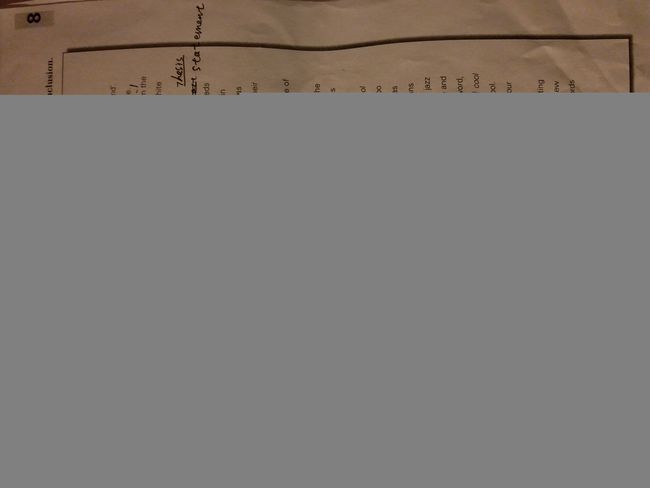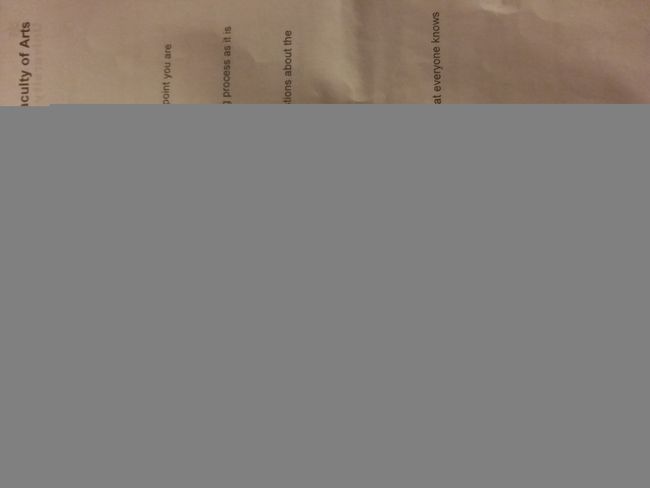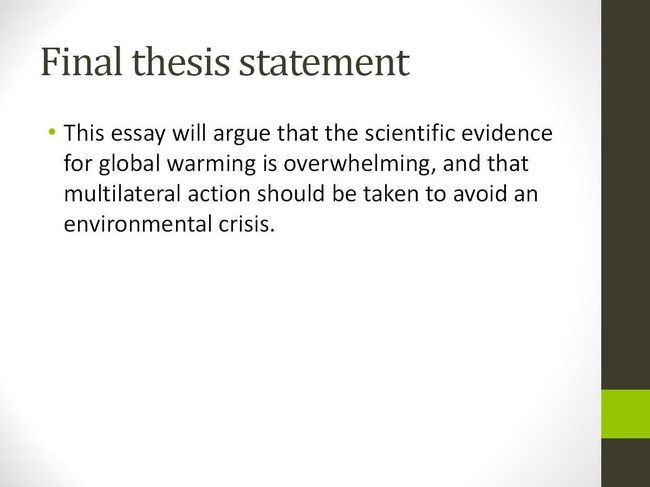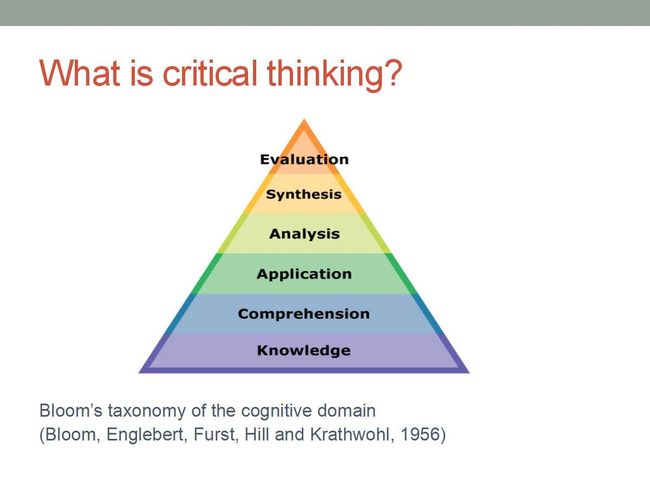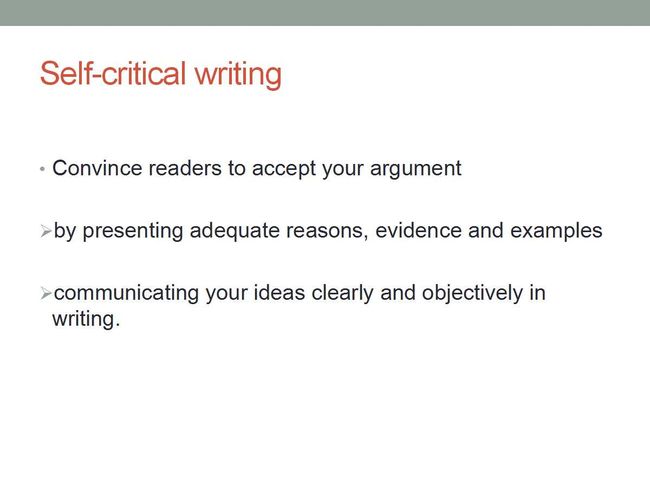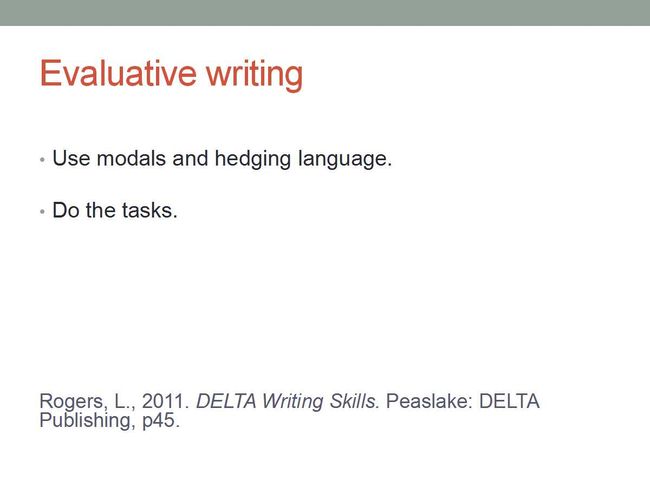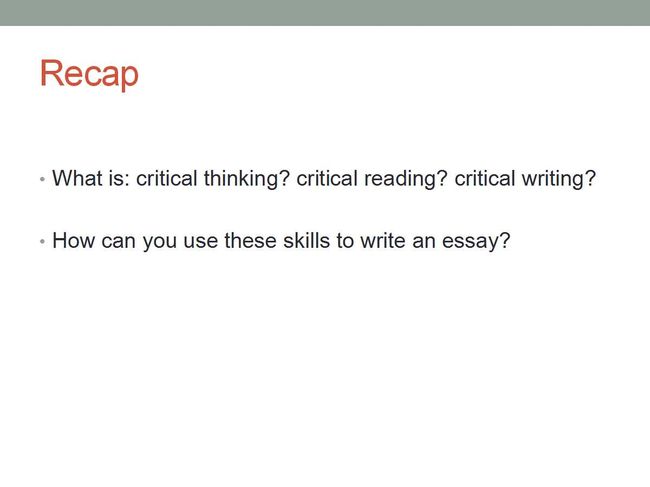21th February 2017
1 Essay organisation and thesis statements
Essay Organization
There are various types of writings assignments an instructor may give such as journals, reaction papers, questions to be answered, paragraphs on topics or questions, essays, and research papers.
An essay is a writing on a specific question or topic. Instructors may vary in what they are expecting when they assign an essay. It’s important to always ask your instructor if you are not sure. Some may simply want a discussion on a topic or question and are not asking for formal organization.
Others may be expecting a formal academic essay, also called a thesis-and-support paper, organized with an introduction, body, and conclusion that includes the following:
an introductory paragraph which gives a background and states the thesis (the point of the essay),
body paragraphs which contain proof, also called supporting ideas, of the thesis statement, and
a concluding paragraph which sums up the proof and restates the thesis.
While some instructors may have slight variations about formal essay organization, you won’t have a problem if:
you put the thesis statement at the end of the introductory (opening) paragraph
the body paragraphs contain only proof of the thesis
the concluding paragraph contains a review of the proof and restatement of the thesis. Some instructors also ask for some general prediction or observation instead of or in addition to a restatement of thesis.
Always check with your instructor if you are not sure about what is expected. The discussion here is for a formal academic essay (thesis-and-support paper).
What is an essay and how should it look?
An essay is a collection of paragraphs that fit around one idea or position on an issue. This is usually called the thesis or main idea.
The sentence that contains the main idea is called the Thesis Statement. The Thesis Statement must take a position and not just state a fact. While some instructors vary on where a thesis statement may appear, it is safe to place it as th last sentence of the first paragraph.
An academic essay must have at least three paragraphs: an introduction, a body paragraph, and a concluding paragraph. Since there should be a separate body paragraph for each proof point, the more substantial the proof, the more paragraphs there will be. A typical essay of about five hundred words will usually have at least two or three proof paragraphs making the essay four to five paragraphs.
Instructors often require a specific page format (margins, line spacing, and so on). Page formatting is part of the requirements of a style system. Both MLA and APA have similar formatting requirements. Unless your instructor states otherwise, it use MLA page format.
Sample Paper – Modern Technology – Screen Shot
Outline – Modern Technology
Parts of an Essay
In a way, these academic essays are like a trial in court. The attorney, whether prosecuting the case or defending it, begins with an opening statement explaining the background and telling the jury what he or she intends to prove (the thesis statement). Then, the attorney presents witnesses for proof (the body of the paragraphs). Lastly, the attorney presents the closing argument (concluding paragraph).
The Introduction
There are a variety of approaches regarding the content of the introduction paragraph such as a brief outline of the proof, an anecdote, explaining key ideas, and asking a question. In addition, some textbooks say that an introduction can be more than one paragraph. The placement of the thesis statement is another variable depending on the instructor and/or text. The approach used in this lesson is that an introduction paragraph gives background information leading into the thesis, the main idea of the paper, which is stated at the end.
The background in the introductory paragraph consists of information about the circumstances of the thesis. This background information often starts in the introductory paragraph with a general statement which is then refined to the most specific sentence of the essay, the thesis. It is important to note that in this approach, the proof for the thesis is not found in the introduction except, possibly, as part of a thesis statement which includes the key elements of the proof. Proof is presented and expanded on in the body.
The thesis is the position statement. It must contain a subject and a verb and express a complete thought. It must also be defensible. This means it should be an arguable point with which people could reasonably disagree. The more focused and narrow the thesis statement, the better a paper will generally be.
If you are given a question in the instructions for your paper, the thesis statement is a one-sentence answer taking a position on the question.
If you are given a topic instead of a question, then in order to create a thesis statement, you must narrow your analysis of the topic to a specific controversial issue about the topic to take a stand. If it is not a research paper, some brainstorming (jotting down what comes to mind on the issue) should help determine a specific question.
If it is a research paper, the process begins with exploratory research which should show the various issues and controversies which should lead to the specific question. Then, the research becomes focused on the question which in turn should lead to taking a position on the question.
These methods of determining a thesis are still answering a question. It’s just that you pose a question to answer for the thesis. Here is an example.
Suppose, one of the topics you are given to write about is America’s National Parks. Books have been written about this subject. In fact, books have been written just about a single park. As you are thinking about it, you may realize how there is an issue about balancing between preserving the wilderness and allowing visitors. The question would then be Should visitors to America’s National Parks be regulated in order to preserve the wilderness?
One thesis might be There is no need for regulations for visiting America’s National Parks to preserve the wilderness.
Another might be There should be reasonable regulations for visiting America’s National Parks in order to preserve the wilderness.
Finally, avoid using expressions that announce, “Now I will prove…” or “This essay is about …” Instead of telling the reader what the paper is about, a good paper simply proves the thesis in the body. Generally, you shouldn’t refer to your paper in your paper.
Here is an example of a good introduction with the thesis in red:
Not too long ago, everyday life was filled with burdensome, time-consuming chores that left little time for much more than completing these tasks. People generally worked from their homes or within walking distance to their homes and rarely traveled far from them. People were limited to whatever their physical capacities were. All this changed dramatically as new technologies developed. Modern technology has most improved our lives through convenience, efficiency, and accessibility.
Note how the background is general and leads up to the thesis. No proof is given in the background sentences about how technology has improved lives.
Moreover, notice that the thesis in red is the last sentence of the introduction. It is a defensible statement.
A reasonable person could argue the opposite position: Although modern technology has provided easier ways of completing some tasks, it has diminished the quality of life since people have to work too many hours to acquire these gadgets, have developed health problems as a result of excess use, and have lost focus on what is really valuable in life.
Quick Tips:
The introduction opens the essay and gives background information about the thesis.
Do not introduce your supporting points (proof) in the introduction unless they are part of the thesis; save these for the body.
The thesis is placed at the end of the introductory paragraph.
Don’t use expressions like “this paper will be about” or “I intend to show…”
For more information on body paragraphs and supporting evidence, see Proving a Thesis – Evidence and Proving a Thesis – Logic, and Logical Fallacies and Appeals.
The Body
Body paragraphs give proof for the thesis. They should have one proof point per paragraph expressed in a topic sentence. The topic sentence is usually found at the beginning of each body paragraph and, like a thesis, must be a complete sentence. Each topic sentence must be directly related to and support the argument made by the thesis.
After the topic sentence, the rest of the paragraph should go on to support this one proof with examples and explanation. It is the details that support the topic sentences in the body paragraphs that make the arguments strong.
If the thesis statement stated that technology improved the quality of life, each body paragraph should begin with a reason why it has improved the quality of life. This reason is called a topic sentence. Following are three examples of body paragraphs that provide support for the thesis that modern technology has improved our lives through convenience, efficiency, and accessibility:
Almost every aspect of our lives has been improved through convenience provided by modern technology. From the sound of music from an alarm clock in the morning to the end of the day being entertained in the convenience of our living room, our lives are improved. The automatic coffee maker has the coffee ready at a certain time. Cars or public transportation bring people to work where computers operate at the push of a button. At home, there’s the convenience of washing machines and dryers, dishwashers, air conditioners, and power lawn mowers. Modern technology has made life better with many conveniences.
Not only has technology improved our lives through convenience, it has improved our lives through efficiency. The time saved by machines doing most of the work leaves more time for people to develop their personal goals or to just relax. Years ago, when doing laundry could take all day, there wasn’t time left over to read or go to school or even just to take a leisurely walk. Nowadays, people have more time and energy than ever to simply enjoy their lives and pursue their goals thanks to the efficiency of modern technology.
Accessibility to a wide range of options has been expanded through modern technology. Never before could people cross a continent or an ocean in an afternoon. Travel is not the only way technology has created accessibility. Software which types from voice commands has made using computers more accessible for school or work. People with special needs have many new options thanks to modern technology such as special chairs or text readers. Actually, those people who need hearing aids as a result of normal aging have access to continued communication and enjoyment of entertainment they did not previously have. There are many ways technology has improved lives through increased accessibility.
Notice how these proof paragraphs stick to one proof point introduced in the topic sentences in red. These three paragraphs, not only support the original thesis, but go on to give details and explanations which explain the proof point in the topic sentence.
Quick Tips:
The body of your essay is where you give your main support for the thesis.
Each body paragraph should start with a Topic Sentence that is directly related to and supports the thesis statement.
Each body paragraph should also give details and explanations that further support the poof point for that paragraph.
Don’t use enumeration such as first, second, and third. The reader will know by the topic sentence that it is a new proof point.
The Conclusion
Instructors vary of what they expect in the conclusion; however, there is general agreement that conclusions should not introduce any new proof points, should include a restatement of the thesis, and should not contain any words such as “In conclusion.”
Some instructors want only a summary of the proof and a restatement of the thesis. Some instructors ask for a general prediction or implication of the information presented without a restatement of thesis. Still others may want to include a restatement along with a general prediction or implication of the information presents. Be sure to review assignment instructions or check with instructor. If your assignment instructions don’t specify, just sum up the proof and restate the thesis.
Example which sums up proof and restates thesis:
Modern technology has created many conveniences in everyday from waking up to music to having coffee ready to getting to work and doing a day’s work. The efficiency provided by technology gives people more time to enjoy life and pursue personal development, and the accessibility has broadened options for travel, school, and work. Modern technology has improved our lives through convenience, efficiency, and accessibility.
See how the thesis statement was restated in red. The two major arguments about the possible locations proven to be incorrect were also included to remind the reader of the major proof points made in the paper.
Example which makes a general prediction or implication of the information presented:
Modern technology has created many conveniences in everyday life from waking up to music to having coffee ready to getting to work and doing a day’s work. The efficiency provided by technology gives people more time to enjoy life and pursue personal development, and the accessibility has broadened options for travel, school, and work. Without it, everyday life would be filled with burdensome tasks and be limited to our neighborhood and our physical capacity.
Here’s an example of a conclusion with a general prediction or implication statement with a restatement of thesis.
Modern technology has created many conveniences in everyday life from waking up to music to having coffee ready to getting to work and doing a day’s work. The efficiency provided by technology gives people more time to enjoy life and pursue personal development, and the accessibility has broadened options for travel, school, and work. Without it, everyday life would be filled with burdensome tasks and be limited to our neighborhood and our physical capacity. Modern technology has improved our lives through convenience, efficiency, and accessibility.
Unity and Coherence
Essays must have unity. They must clearly stay focused on one purpose: proving the thesis. All the sentences in each paragraph and each paragraph must work together to achieve that purpose. It is critical for each sentence in each paragraph to start with a topic sentence that states a reason why the thesis is right and that the rest of the sentences in the paragraph support that topic sentence.
Essays must have coherence. Each sentence must flow smoothly and logically into the next. Each paragraph must flow smoothly and logically into the next. Words and word groups called transitions must be used to link one sentence to the next and one paragraph to the next.
Sample Essay – Modern Technology
Sample Essay – Modern Technology – Showing Organization of Paragraphs
Quick Tips:
The conclusion brings the essay to an end and is typically the shortest paragraph.
It is important to not introduce new ideas or information here.
Unless otherwise specified in your assignment, just sum up the proof and restate the conclusion.
Some instructors may want the concluding paragraph to contain a general prediction or observation implied from the information presented.
Appropriate Language
Generally speaking, use Standard English vocabulary and grammar is expected. These types of papers should not sound as though you were talking casually to a friend. Don’t use slang, for example, such as ok. Also, while we use second person (you, your) in informal speech, formal academic writing should not use second person since the reference is not specific. Here’s an example. You should know where your children are. The reader may not have young children or any children at all. Here’s an example with clear reference. Parents of young children should know where their children are.
Instructors will vary about accepting the use of first person (I, me, my, we, us, our) in essay writing. While first person may be appropriate in journal writing or reaction papers, typically, instructors will require third person (not first or second) in formal essays and research essays. Be aware of requirements for any particular assignment.
Formal academic essays should not include sentences that refer to yourself or the paper. Don’t use statements such as “In the opinion of this writer (referring to yourself)….” or “This paper will show….”
For more information on language use, see Appropriate Language.
Summary
The important thing in essay writing is to have a point, thereby knowing what you are trying to prove, and stick to that point. Keep it simple and focused.
This format is the basis for writing a research paper as well. If you can get the idea in a simple essay, writing research papers will be much easier.
Sample Essay on Physical Fitness in MLA Page Format without Research
More information on writing an essay can be found at The Writing Process, Outlining, and Appropriate Language.
For information on writing a research paper, see How to Write a Research Paper.
2 Critical Thinking
3 Practical writing
Listen to the following text read by Theresa, and take down the main problems.
2. Ss write a letter to the hen to give her advice
3. swap the letter and change the ideas.
4. Give some mateirals and practise writing the topics.
Write the letters to each other, and summary

